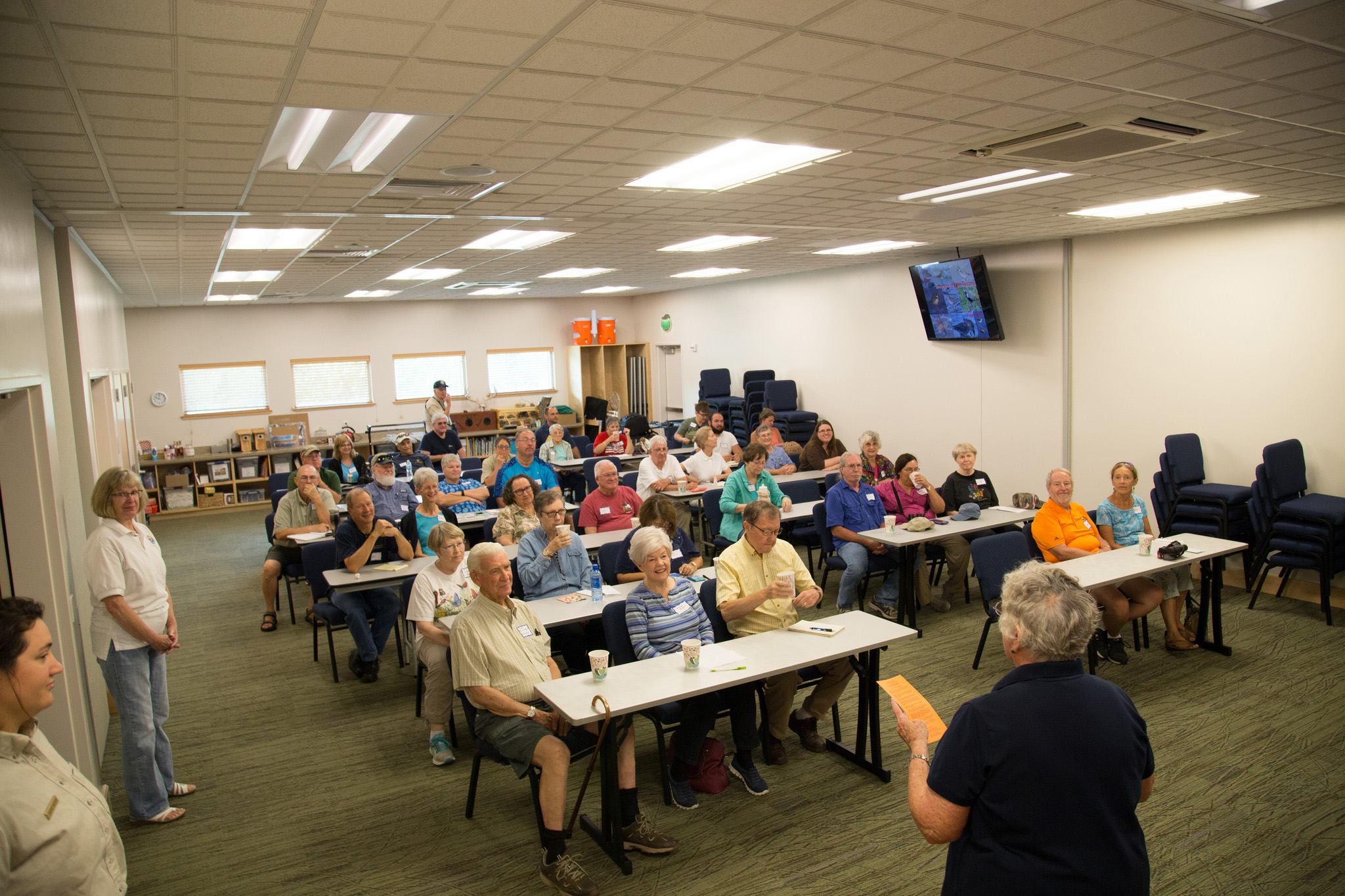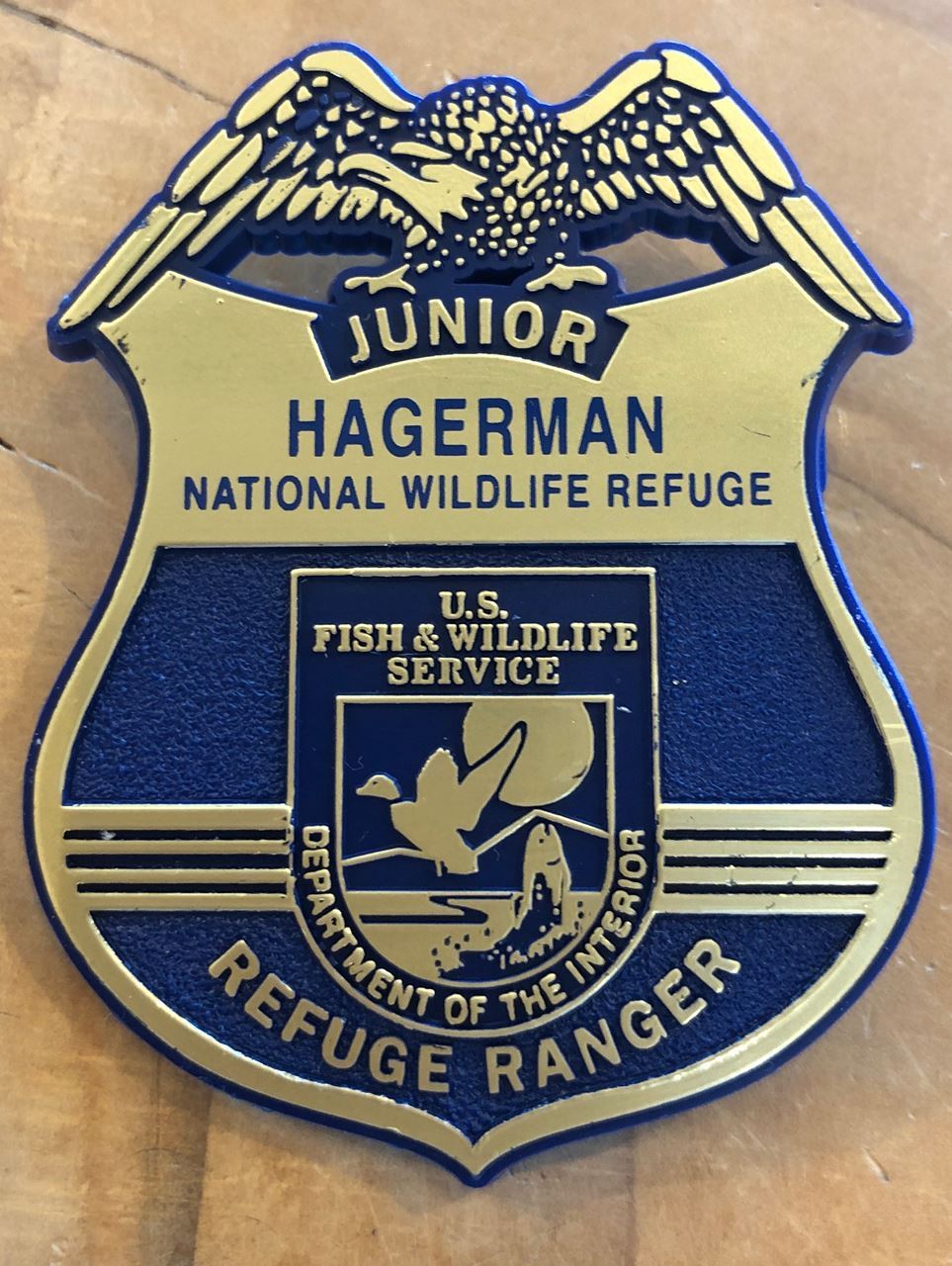|
Nature’s Resilience in Action By Kathy Whaley, Refuge Manager
Photo by Pam Rendall-Bass From late April through early July, much of Hagerman National Wildlife Refuge was under water. The normal spring/summer Lake Texoma level is around 618’ MSL. Having reached a height of 635.3’ on May 10, water was almost 18 feet higher than it should have been. At this point, 15-16 feet of water covered Wildlife Drive, Plover, Tern, Egret, and much of Bennett and Silliman Roads which lasted for about 8 weeks. Great Blue Herons, Great Egrets, Snowy Egrets, Mallards, resident Canada Geese, beaver, and many other birds and wildlife did not mind. They simply adapted by using additional or different areas than usual for their daily routines of foraging and loafing. Plants, on the other hand, did mind. Wildflowers that usually line Wildlife Drive and fill the farm fields with flashes of red, pink and yellow; buttonbush along the roads and marsh edges; willow trees, American lotus, and cattails – they all disappeared under the water where sunlight was nowhere to be seen. Stems and leaves turned brown, rotted, then fell off. The roads? They minded, too. A layer of silt and sand from the lake covered each of them several inches deep, burying what little actual gravel remained. Picnic tables, sidewalks, and most of the large shade canopy at Big Mineral Day Use Area were submerged. The new vault toilet had water half-way to the ceiling inside leaving grime, dirt, and who knows what else on the walls and toilet seat (never fear! It was pressure washed and super sanitized and is now open). |
bright green with a variety of fresh, new growth. Grasses in the picnic area by Big Mineral Creek are alive and well and cattails that were becoming prolific in Steedman Marsh have been set back for now (which is a good thing). Wading birds are again strutting through Muleshoe Marsh with their long, spindly legs. Visitors are back meandering down wildlife drive with their cameras and phones in hand looking for that next good photograph.
|
Thanks to our incredible, dedicated volunteers and Equipment Operator Kevin Beene (stationed at Tishomingo Refuge) the roads and trails have been mostly cleared and are open for visitors. Huge trees and limbs were pushed off roads, large holes and ruts in roads and trails have been patched. Picnic tables, the canopy, and sidewalks at Big Mineral Creek were pressure-washed. Bluebird boxes on Raasch Trail that were destroyed have been replaced by John VanBebber and the nest box crew. Some of the boxes are already active again! Friends of Hagerman President Cathy VanBebber coordinated a clean-up day where around 15 volunteers came to pick up trash along roads and trails (several hundred pounds of trash was removed!). Thank you Alice Anderson, Sandra Anderson, Sue Abernathy, Karen Glenn, Sharon Barker, Brittany Smith, Maegan Clark, Connie & Carey Hardesty, Trey Crosthwaite, and Boy Scout Troop 298 out of Frisco for helping with litter removal. Workampers Melissa and Brandon Bostic along with Ranger Spencer Beard cleaned A LOT of informational and interpretive signs and are working to replace missing signs. Administrative Officer Tim Magee, Oil & Gas Specialist Mary Maddux, and Ranger Beard used a Skidsteer and trailer to clear large wood debris from the farm fields to help prepare for plowing and planting winter wheat. A huge thank you to the Hagerman Mowing Team - John Van Bebber, Mike Grubb, Larry Vargus, Jim Mrozinski, Derek Miller, Bryon Clark, Wes Crawford, Jay McCurley, Rick Roberson, Wayne Meyer, and Joe Frank - for keeping the grass around the Visitor Center and maintenance complex PLUS all the hiking trails trimmed, mowed and looking great. This crew also completed a lot of debris removal and trail repairs on Harris Creek Trail. Kudos! Thank you also to the awesome volunteers who help orient our visitors and keep the Friends of Hagerman Nature Nook operating - Pat Crone, Patricia Crane, Fran Terrell, Nana Rylander, Ginger Heiman, Wanda Holcomb, Bob Moses, Sam Crowe, Roger Peckenpaugh, Nelda Zamir, Danny Brakebill, Jean Jones, and any others I missed. Many Friends of Hagerman Board of Directors’ members are included above. In addition to members Cathy, John, Derek, Wayne, Patricia, and Karen, Board Members Sherry Howard, Cindy Steel, Pat Goodrum, Donna Rogers, Margaret Avard, Bert Garcia, Laurie Sheppard, and Kim Tingle contribute so much of their time and energy to make this refuge the best it can be for ALL of us! They are true warriors for Hagerman National Wildlife Refuge-stepping in to help in whatever way the refuge and staff needs them. Especially after having lost three staff members to the Deferred Retirement Program earlier this year (including all refuge heavy equipment operators), the impact and value of having these people step up day after day for the refuge is immeasurable.
Photo by Nancy Miles Miller These beautiful lands are masters of resilience. The capacity of the ecosystem to deal with periodic severe disturbance, adapt, and recover all while maintaining the essential function of providing habitat for critters is quite impressive. Thankfully, we do not see flooding to this extent very often, but it will undoubtedly happen again. When it does just remember how quickly Mother Nature heals her wounds. Refuge Update: |
All hiking trails are clear, all roads are open. The Lotus Flowers are still in bloom on Meadow Pond Trail. Enjoy!
Photos by Murali Hanabe
The Photo Club enjoyed a lovely morning admiring the stunning lotus flowers, still in bloom—but be prepared to walk two miles along Meadow Pond Trail to see them!
Upcoming Activities:
The Friends of Hagerman is Hosting 7 Family Friendly Events in 2025! Donate to help fund programs like these! |
|
Adopt-A-Goose (Or An Entire Field) Feed the Snow and Ross's Geese Over-Wintering at Hagerman National Wildlife Refuge Each winter, thousands of Snow and Ross’s geese visit Hagerman National Wildlife Refuge (HNWR). These geese have migrated thousands of miles from nesting grounds near the Arctic Circle to HNWR. To provide a vital food resource for these exhausted and hungry travelers, HNWR plants fields of winter wheat. The Friends of Hagerman National Wildlife Refuge (FoH) sponsors the “Adopt-a-Goose” fund raiser to help offset budget constraints of the refuge and purchase the wheat seed needed to plant the fields. Please consider supporting our effort with your generous donation. How Can You Help? Adopt a Goose · Your $20 donation will buy one bag of wheat seed Adopt an Entire Field · The donation levels listed below will buy enough seed to plant the entire field
|
Plant of the Month: The Mexican Plum Tree Article and Photo by Marnie Barnes Sadri
“Would a rose by any other name smell as sweet?” (Romeo & Juliet) Well, it just might—if it were a Mexican Plum Tree! A proud member of the rose family (Rosaceae, Prunus mexicana), the Mexican Plum tree checks all the boxes for many gardeners. According to the Lady Bird Johnson Wildflower Center, its delicately sweet-scented flowers—ranging from white to pink—are self-fertile and bloom in late winter to early spring, making them a vital early food source for pollinators. The Mexican Plum is a well-mannered, single-trunked tree that won’t spread or crowd out neighboring plants like some other native plum species. Typically growing 15 to 25 feet tall—and rarely exceeding 35 feet—it’s a great fit even for smaller gardens. This beautiful tree is also an important larval host for several insect species, most notably the Tiger Swallowtail butterfly and the striking Cecropia Moth. When it comes to growing conditions, the Mexican Plum is quite adaptable. It tolerates partial shade (or full sun, which is best for fruit production) and prefers moist, light to medium soils—sandy or loamy—but it can also handle heavier clay. Best of all, it’s tough enough to withstand Texas’ famously hot, dry summers, making it a reliable and rewarding addition to your landscape. The small fruit of the Mexican Plum can range from tart to sweet, depending on growing conditions, with a flavor often described as a cross between a peach and a plum. It can be enjoyed fresh, transformed into a beautifully colored, delicious jam, or even fermented into wine. These jewel-like fruits make a perfect addition to a summer or fall charcuterie board. Historically, the bark, seeds, and leaves of the Mexican Plum tree have been used for medicinal purposes. However, according to PracticalPlants.org, caution is advised—while these parts may offer benefits in trace amounts, they contain compounds linked to cyanide. For this reason, the medicinal use of the Mexican Plum is best left to those with expertise in medical botany or phytotherapy. In the fall, the leaves of the Mexican Plum tree can vary with shades of vibrant red and golden yellow with green. As the tree matures, the bark transforms from dark gray striations on the limbs and trunk to black or gray, shaggy “plates”. These characteristics offer visual interest in the garden as the jewel colored leaves blaze into winter. |
Second Saturday: Dragonflies and Damselflies with Dr. Wayne Meyer Saturday, August 12, 2025 at 10:00 AM in the Visitor Center Photo by Brenda Kay Edwards Fun Facts: Did you know that there are over 5,000 species of dragonflies and they all belong to the order Odonata, which means "toothed one" in Greek or that some species of dragonfly live only a few weeks, while others can live up to a year. Come hear Dr. Meyer talk about how dragonflies and damselflies live and a discussion of some of the ones that live on Hagerman NWR. Photo by Brenda Kay Edwards Future Second Saturday Programs |
|
|
Butterfly Garden Walks
Registration is not necessary |
Pipevine Swallowtail (right) by Laurie Sheppard |
Birding with Jack: The Weekly Bird Census Left to Right: Mike Petrick, Nancy Riggs, Jack Chiles and Terry Goode Each Tuesday a team of experienced birders, including Master Naturalist Jack Chiles, traverse 35 miles of refuge roads and hiking trails, documenting every bird they encounter. This Bird Census is reported to The Cornell Lab of Ornithology for use in research, and each week we will bring you a link to their actual bird count, and a summary of their adventures.
Watch for the census results every Tuesday evening: Bird Census Results |
The Annual Nature Photography Contest, sponsored by the Friends of Hagerman NWR, is open to photographers of all ages and skill levels. Children are especially encouraged to participate in the Beginner category. Ribbons and cash prizes will be awarded across multiple divisions and categories, including a special Best in Show for Youth. |
Contest Entry Rules and Instructions. Entries will be accepted until September 30, 2025
Join Cindy Steele for: The Refuge Rocks! Programs for Children Future events (Registration Required)
|
| Puddles' Craft Corner By Cindy Steele, Master Naturalist |
The Humming Sound of Summer!
Welcome back to Puddles’ Craft Corner. You just know it’s gonna be a scorcher when you hear the cicadas in the morning. They sound like 90 degrees in August; like sizzling, sticky heat bubbling over and down the tops of the trees around you. They sound like ice cream trucks, lawnmowers, kids playing in the pool, and the clink of ice in a glass of lemonade—cicadas stealthily singing in the backdrop as if they were there all along.
A cicada is an insect of the order Hemiptera, suborder Auchenorrhyncha, in the superfamily Cicadoidea, with big eyes wide apart on the head and usually transparent, well-veined wings. There are approximately 2,500 species of cicada around the globe. Cicadas live in warm climates where they are one of the most widely recognized of all insects, mainly due to their large size and remarkable (and often inescapable) acoustic talents. Cicadas are sometimes called "locusts", although they are unrelated to true locusts, which are a kind of grasshopper. Cicadas are actually related to leafhoppers and spittlebugs.
Cicadas start their lives as eggs. Females lay 200 to 400 eggs in tiny holes that they make in the branches of trees and shrubs. After six to 10 weeks, cicada young, called nymphs, hatch from the eggs, and immediately fall to the ground. They burrow underground and attach to tree roots. The nymphs stay buried to suck tree sap from two to 17 yea dormant period—ends, the cicadas emerge above ground at sunset on a sizzling summer day, climb the trunk of a nearby tree, and shed their skin. Now, they’re adult cicadas. This is the time the male cicadas fill the air with shrill buzzing sounds created by rapidly vibrating drum-like plates on their abdomens. The females make clicking sounds with their wings if they like the song. They mate, lay their eggs, and then both male and female cicadas die after just about five weeks above ground. The female makes pockets to hold her eggs in the twigs of trees. The pockets can hold about 25 eggs and some twigs can have 20 pockets in them. Scientists divide the over 2,500 cicada species into two groups: annual and periodical. Annual cicadas emerge
from the ground at various times each summer. They’re usually dark with greenish markings. These insects avoidrs, depending on the species. When this underground life—called the,,,
Continue to the Lesson and full Instructions.
Junior Ranger Program
|
| The Junior Ranger Pledge As a Junior Ranger at Hagerman National Wildlife Refuge, I pledge to protect outdoor creatures small, big and huge. To keep the water, air and land clean. To make enjoying nature a routine. I will share my new skills with family and friends. When people and nature work together, everybody wins! |
|
Sponsors Enable the Friends to…
Introducing New Membership Levels! All memberships now include your family and the Photo Club Join Today! Memberships available for $20 |
Photo by Cathy Van Bebber | Sunrise at the Little Sit by Laurie Sheppard |
Meet Jack and the Bird Census Team and learn how to identify the birds of North Texas while enjoying the beautiful sunrise over Lake Texoma! Modeled after Cornell's national "Big Sit" event, a group of dedicated birders invite you to join them at sunrise to conduct a bird count as multiple species fly to the water and the surrounding land to feed. Leaders will bring spotting scopes and will provide tips for identification of the many species you will see. This event lasts a couple of hours, but all are welcome to come and go as they please. Participants are advised to bring a chair, binoculars and water. The First Saturday of every month, beginning 30 minutes before sunrise.
|
Please register (optional) so we may inform you of unexpected changes. Click to enlarge map: |
|
Do You Like to Work Outside? The Refuge Needs You! |
It takes a lot of people to have a beautiful garden! The Wednesday Garden Team Love to work with native plants and meet other gardeners? Come and help us add plants, weed and mulch our beautiful butterfly garden. Garden Team volunteers get first dibs on thinned native plants as well as access to seeds and cuttings for propagation. Gardeners meet on most Wednesdays, but times vary. Contact Us to subscribe to the volunteer garden team weekly email. Provide own tools and gloves. Minimum age 18, or 16 if accompanied by parent/volunteer. |
Mowing and Refuge Beautification: The Work Crew Do you enjoy working outside, mowing, sprucing up hiking trails, trimming and removing brush and general cleanup? Show your love for nature by joining the Outdoor Crew at Hagerman National Wildlife Refuge. Outdoor Crew volunteers meet on the First Tuesday and Fourth Saturday of every month. Contact Us for exact times, dates and other details about joining the volunteer Work Crew. Scouts welcome! |
Visitor Center Volunteers Needed! |
Do you enjoy meeting all kinds of people from all over the world, and like-minded people in our area? If yes, consider joining our team of Visitor Center Volunteers. You will greet refuge guests, distribute maps and other refuge information, and make sales in the gift shop. Shifts available every day of the week: Monday through Saturday 9 AM to 12:30 PM and 12:30 to 4:00 PM, Sunday 1:00 to 5:00 PM. Training is provided. Contact Us if interested. |
| Thank You To Our Contributors: Jack Chiles, Marnie Barnes Sadri, Nancy Miles Miller, Pam Rendall-Bass, Cindy Steele, Mayve Strong, Kathy Whaley Refuge Manager: Kathy Whaley Visitor Services Manager: Spencer Beard Friends of Hagerman NWR Foundation 6465 Refuge Road, Sherman, TX 75092 Phone: 903-786-2826 Join us on Facebook: |
Search for any word--do not use quotes for phrases |
Kroger: Stop by the customer service desk at Kroger and link your Kroger Card to the Friends of Hagerman: the Friends will get rewards for every dollar you spend, at no cost to you.
Please add info@friendsofhagerman.org to your contacts to ensure delivery of registration confirmations, account information and the Featherless Flyer
See you at the refuge!









.jpg)












